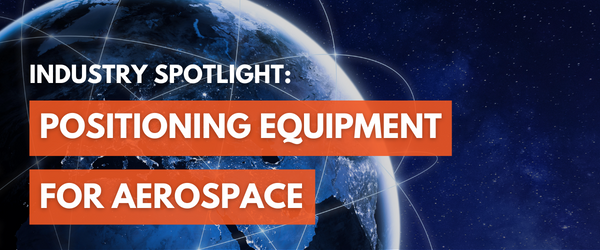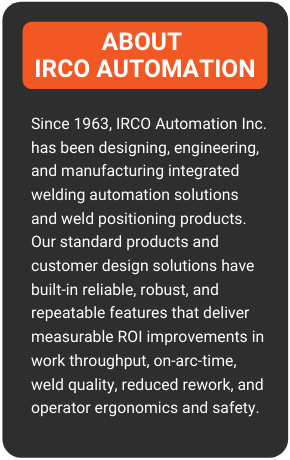In the past 5 years, the number of artificial satellites orbiting the earth has seen exponential growth as a result of the wide adoption of low-orbit telecommunications satellites for consumer internet services and the increased commercial availability of launch provider services. The aerospace industry is now facing a new challenge of scaling up their production rates to meet this new demand while maintaining the highest standards of build quality. With the large, fragile nature of these systems, and special requirements for clean room compliance, a new era of industrialization is upon us. Keep reading to find out how IRCO is leveraging decades of expertise building positioners of all sizes, with unparalleled design and customization flexibility to address these specific hurdles and help our aerospace partners reach their horizons.
In this post, our guest writer, Matt, explores the industrialization of spacecraft vehicle assembly and the next generation of positioning equipment.
Read on below!
Sections:
Positioning Equipment for Aerospace
What is your first though when you hear the word positioner? Positioning equipment is often exclusively associated with heavy industry fabricators, welders, and large equipment manufacturers. Over the past several decades, many companies within this domain have seen incredible growth, and IRCO has always been proud to support them as they continually push the boundaries of their production capabilities. As the industry matured and components became more complex, we experienced the progressive introduction of automation into these systems, starting with minor improvements on existing concepts, and progressing through to custom designed, fully autonomous, turn-key solutions.
Through this evolution, we have credited our success to our underlying design philosophy; get the part into the best position first, then work backwards from there. This might sound obvious since we are on the topic of positioning equipment, but as these components become vastly more complex, the methods for orienting them in the optimal position for a given operation have required significant revaluation. No industry is a better testament to this hurdle than aerospace, and specifically satellite assembly.
Positioning Requirements of the Aerospace Industry:
Due to their complexity, fragility, and often awkward shapes, spacecraft have traditionally been assembled by hand. Recently however, advancements in satellite technology and commercialization of launch provider services have unleashed a new realm of possibilities for an era of spacecraft aimed at providing services directly to consumers. The demand for low earth orbit telecommunications satellites has skyrocketed, expanding the reaches of internet and mobile phone service to vast populations who are outside the reach of traditional infrastructure. Additionally, defense and navigation constellations continue to grow, bringing with them cutting edge imaging and locating capabilities. The production of new (and replacement of existing) satellites in enormous quantities is now a necessity, and at this scale, manual assembly simply won’t succeed without significant intervention.
While IRCO has always been a key supporter of welding integration systems, we are at our core a material handling and positioning company. The overwhelming majority of the value we offer comes from first understanding how to manipulate workpieces into the best position. In doing so, the subsequent introduction of additional fabrication processes (such as welding) is frequently relatively straightforward and convenient. With our 60+ years of experience in this domain across tens of thousands of projects, incorporating all levels of part complexity and automation integration, we are uniquely suited to offer industry-leading insight for this exciting new era of industrialization.
How does IRCO’s equipment deal with the unique requirements of spacecraft assembly?
(AKA: How is IRCO's approach different than other providers?)
In addition to increased safety requirements, the fragile nature of high-tech electronic systems presents some unique assembly challenges. Particular care must be taken to handle workpieces delicately, stably, rigidly, and with added protections from hazards such as static electricity and particle contaminants. Various stages of the assembly process may have different clean room requirements, which have unique levels of tolerance for exposure to lubricants, degassing of paint compounds, and spalling of mating surfaces.
IRCO has been providing custom design solutions for decades reaching every corner of the manufacturing world. We recognize that every customer is unique; their processes, concerns, and project-specific requirements have pushed us to innovate at every turn to address some of the hurdles for which no standard solution exists. Many of the individual problems associated with the rapid industrialization of the aerospace community are challenges that we have helped our customers overcome in the past. This familiarity, combined with our intimate knowledge of positioning, has allowed us to develop exceptionally efficient offerings to address the concerns of the aerospace industry.
By integrating every level of automated systems, we are able to provide custom tailored solutions to fit your budget and project requirements. By evaluating the needs of your process, we can help you determine if your system will require servomotors for a high degree of repeatability and precision, or if a reduced-speed AC gearmotor will satisfy your fine-control requirements at a fraction of the price. If your technicians are going to be manipulating the spacecraft manually, then our most basic controls packages that combine operator pendants and foot pedals may offer you an economical interface with our machinery. However, with the inclusion of a basic automation package, we can provide you with a Human Machine Interface (HMI, or industrial touch-screen tablet) that allows you to teach preprogrammed positions to automatically drive the machine to a set location for each stage of assembly, giving you optimal and consistent positioning every time. This basic automation package also opens the door to many supplementary sensor systems, such as laser area scanners with programmable dead-zones to ensure that no part of your equipment comes anywhere near the ground, and that personnel are at a safe distance form the machinery during movement. Finally, with the inclusion of full PLC systems, the IRCOpulse production monitoring system can provide you with real-time metrics and historical reporting/trending on all of your associated manufacturing KPIs.
In addition to automating movement, IRCO has developed our aerospace positioning systems to comply with almost any mechanical requirements for spacecraft handling. For example, our unique 3-axis beam positioner provides unparalleled versatility for manipulating large and heavy parts. Although this system is driven hydraulically, we are able to offer clean room compliance through custom coverings on our actuation components, carefully selected lubricants, and the elimination or strict mitigation of all potential contaminant producers.
Stability is often a primary concern for spacecraft assemblers, with fixturing and machinery incorporating strict controls for stability under normal operation and during seismic events. Most of our systems are designed to be free-standing at their rated load, meaning the casters can be incorporated to allow your vehicle to move between stations without having to detach it from the positioner. The addition of ballast, stabilizer legs, and custom anchoring systems allow us to offer the stability you need for your given level of required mobility.
While safety is paramount on our systems, spacecraft assembly introduces a new paradigm for incident recovery. Many assembly processes involve the use of electric tugs, mobile scissor jack tables, or pump carts to move equipment between stations. In the event of a power failure, our machines are configured to hold the load in the current orientation, but also provide manual low-speed inputs to ensure that the vehicle can always be returned to a position where it can be offloaded and recovered by your facility’s existing lifting equipment.
Making these Customizations with Cost Considerations
By leaning on our vast library of historical designs and standard offerings, we are often able to address project-specific needs with minor modifications to existing systems. With the majority of the engineering work already complete, this ensures that your unique requirements are met in the most cost-effective way possible. Tried and true methods for engineering and building our equipment have led to unparalleled robustness and reliability across years of heavy use.
Many minor customizations offer massive versatility improvements while keeping costs low. For example, we can incorporate your custom fixturing into our machine interface or provide removable and quickly changeable interface options for future-proofing your equipment. In this way, the evolution of your fixturing systems, hole patterns, and attachment points do not need force your machinery into obsolescence or expensive retooling.
If you are an aerospace manufacturer or assembler and would like a consultation around how IRCO can help you meet your industrialization, optimization, efficiency, and production goals, our applications consulting team is eager to take your call. Let us prove to you that we can help you reach your horizons and beyond.
Interested in learning more about Welding Automation?
To get in touch with one of our welding automation specialists, send us an email: info@ircoautomation.com or fill out this form to start a quote.
Or, explore and learn more by visiting one of these pages:
- NEWS: IRCO Delivers Weld Positioners to Aerospace Company
-
Automated Reaming Stations: A Simple Addition to Maximize Productivity
- NEWS: Linear Robot for Box Beam Welding
- Robotic Welding : Key Turn Solutions
To return to our main home page, click here.

.png)

-png.png?width=600&height=125&name=Author%20Headers%20(9)-png.png)

